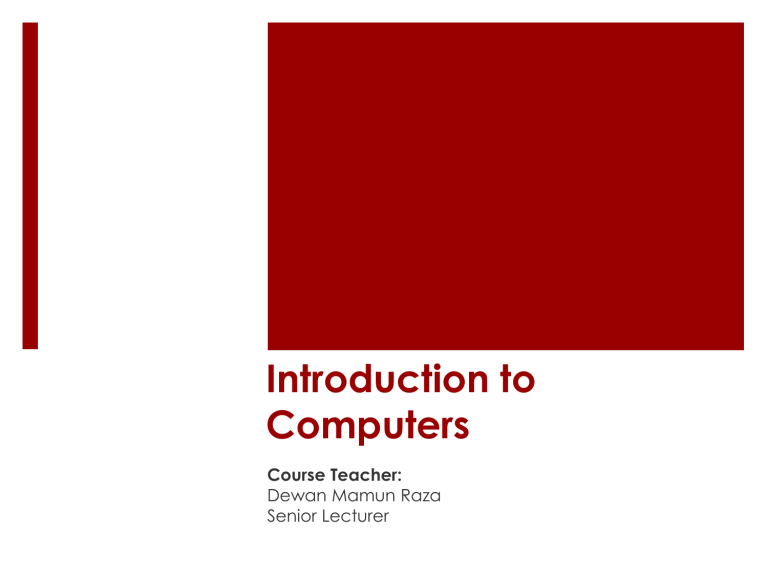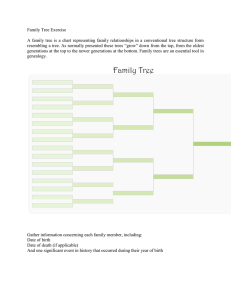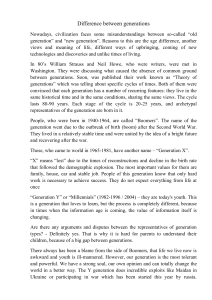
Introduction to Computers Course Teacher: Dewan Mamun Raza Senior Lecturer Learning Objectives In this lecture you will learn about: Computer Data processing Characteristic features of computers Computers’ evolution to their present form Computer generations Characteristic features of each computer generation Computer The word computer comes from the word “compute”, which means, “to calculate” Thereby, a computer is an electronic device that can perform arithmetic operations at high speed A computer is also called a data processor because it can store, process, and retrieve data whenever desired Data Processing The activity of processing data using a computer is called data processing Data is raw material used as input and information is processed data obtained as output of data processing Characteristics of Computers Automatic: Given a job, computer can work on it automatically without human interventions Speed: Computer can perform data processing jobs very fast, usually measured in microseconds (10-6), nanoseconds (10-9), and picoseconds (10-12) Accuracy: Accuracy of a computer is consistently high and the degree of its accuracy depends upon its design. Computer errors caused due to incorrect input data or unreliable programs are often referred to as Garbage-InGarbage-Out (GIGO) Diligence: Computer is free from monotony, tiredness, and lack of concentration. It can continuously work for hours without creating any error and without grumbling Characteristics of Computers Versatility: Computer is capable of performing almost any task, if the task can be reduced to a finite series of logical steps Power of Remembering: Computer can store and recall any amount of information because of its secondary storage capability. It forgets or looses certain information only when it is asked to do so No I.Q.: A computer does only what it is programmed to do. It cannot take its own decision in this regard No Feelings: Computers are devoid of emotions. Their judgment is based on the instructions given to them in the form of programs that are written by us (human beings) Evolution of Computers The abacus is a manually operated digital computer used in ancient civilizations The use of the word abacus dates before 1387 AD Evolution of Computers The first mechanical adding machine (calculator) was invented by Blaise Pascal (French) in 1642 Evolution of Computers Baron Gottfried Wilhelm von Leibniz invented the first calculator for multiplication in 1671 Keyboard machines originated in the United States around 1880 Around 1880, Herman Hollerith came up with the concept of punched cards that were extensively used as input media until late 1970s Evolution of Computers Charles Babbage is considered to be the father of modern digital computers He is best remembered now for originating the concept of a programmable computer He designed “Difference Engine” in 1822 He designed a fully automatic analytical engine in 1842 for performing basic arithmetic functions His efforts established a number of principles that are fundamental to the design of any digital computer Some Well Known Early Computers The Mark I Computer (1937-44) The Atanasoff-Berry Computer (1939-42) The ENIAC (1943-46) The EDVAC (1946-52) The EDSAC (1947-49) Manchester Mark I (1948) The UNIVAC I (1951) Computer Generations “Generation” in computer talk is a step in technology. It provides a framework for the growth of computer industry Originally it was used to distinguish between various hardware technologies, but now it has been extended to include both hardware and software Till today, there are five computer generations Computer Generations 1st Generation Computer Vacuum tube based Vacuum tube Computer Generations 2nd Generation Computer Transistor Transistor based. Computer Generations 3rd Generation Computer IC Computer Generations 4th Generation Computer 5th Generation Computer Key Words/Phrases Computer Integrated Circuit (IC) Computer generations Large Scale Integration (VLSI) Computer Supported Cooperative Working (CSCW) Medium Scale Integration (MSI) Microprocessor Data Personal Computer (PC) Data processing Second-generation computers Data processor Small Scale Integration (SSI) First-generation computers Stored program concept Fourth-generation computers Third-generation computers Garbage-in-garbage-out (GIGO) Transistor Graphical User Interface (GUI) Ultra Large Scale Integration (ULSI) Groupware Information Vacuum tubes





